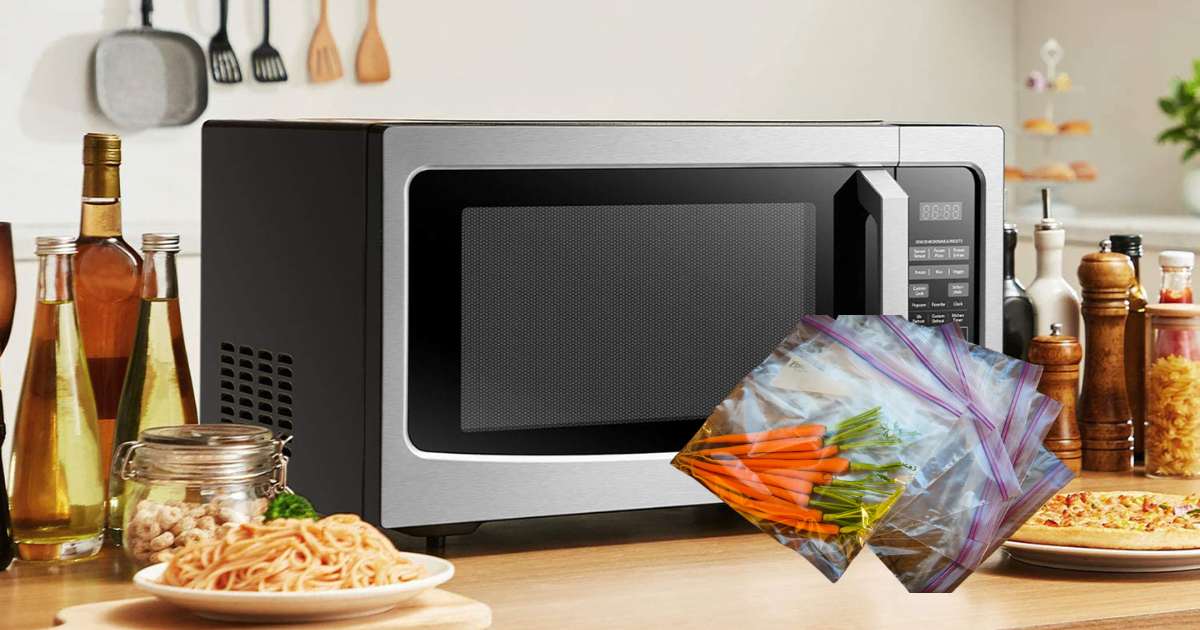In our fast-paced lives, the convenience of Ziploc bags for storing and transporting food can’t be overstated.
Many of you may have found yourselves wondering – can these trusty plastic bags also be used for heating up leftovers or meals in the microwave?
The answer isn’t a simple yes or no, so let’s dive into the details.
Are All Ziploc Bags Microwave-Safe?
Contrary to popular belief, not all Ziploc bags are created equal when it comes to microwave safety.
While some are explicitly designed to withstand the heat, others can release harmful chemicals or even melt when exposed to microwave radiation.
Using a regular Ziploc bag not labeled as “microwave-safe” can be a recipe for disaster, quite literally.
Take this real-life example: Sarah, a busy mom, decided to reheat her kid’s mac and cheese in a regular Ziploc bag for convenience.
A few minutes into the microwave cycle, she noticed an unpleasant plastic smell and found the bag had partially melted, leaching chemicals into the food.
Needless to say, that meal went straight into the trash.
How to Identify Microwave-Safe Ziploc Bags
To avoid situations like Sarah’s, your safest bet is to check the packaging labels for the words “microwave-safe” or similar terminology.
Manufacturers like Ziploc have several product lines explicitly designed for microwave use, such as:
- Ziploc Twist ‘N Loc Containers: Made with a thicker, microwave-safe plastic material.
- Ziploc Storage Bags: Featuring special vents to allow steam release during heating.
- Ziploc Zip ‘N Steam Bags: Designed for cooking and reheating in the microwave.
Here are some typical markers of microwave-safe Ziploc bags:
- Thicker, more rigid plastic construction
- Presence of vents or steam release valves
- Clear “microwave-safe” labeling on the packaging
Microwave Safety Tips for Using Ziploc Bags
Even with microwave-safe Ziploc bags, it’s crucial to follow some basic safety guidelines:
- Don’t Overfill: Leave enough room for expansion to prevent bursting or spills.
- Allow Venting: Make sure there’s a gap for steam to escape, or use bags with built-in vents.
- Limit Heating Time: Check and stir contents regularly to avoid overheating.
- Consider Microwave-Safe Dishes: While convenient, reheating in a proper microwave-safe dish or container is always the safest option.
Surprising Uses for Microwave-Safe Ziploc Bags
Beyond just reheating, microwave-safe Ziploc bags can be surprisingly versatile in the kitchen.
For instance, did you know you can cook an entire omelet or scrambled eggs right in the bag?
Just crack the eggs, add your favorite ingredients, seal the bag (leaving a small vent), and nuke it for a mess-free breakfast!
These special bags can also be a game-changer for meal preppers. You can portion out ingredients, cook them in the bag, and then freeze for easy reheating later. Talk about convenience!
When to Avoid Microwaving Any Plastic
While microwave-safe Ziploc bags and containers are generally considered safe for occasional use, it’s wise to limit excessive or prolonged exposure to heated plastics.
Some experts recommend avoiding microwaving any plastic altogether due to potential chemical leaching concerns, especially with repeated heating cycles.
Whenever possible, opt for microwave-safe glass, ceramic, or high-quality plastic containers explicitly designed for cooking and reheating.
These reusable options are a more eco-friendly choice and eliminate many of the safety concerns associated with single-use plastics.
If you must use the microwave, it’s best to stick to reheating pre-cooked foods rather than actually cooking raw ingredients in plastic bags or containers.
Final Thoughts
In summary, while the convenience of Ziploc bags is undeniable, exercising caution when microwaving them is crucial.
Always double-check for clear “microwave-safe” labeling and follow the manufacturer’s instructions to the letter.
Properly vented, microwave-safe Ziploc bags can be a handy tool for reheating, cooking, and meal prep – but they should never be a replacement for dedicated microwave-safe dishes and containers.
When it comes to your health and safety, it’s better to err on the side of caution.
So the next time you’re tempted to toss that Ziploc bag in the microwave, take a moment to inspect it thoroughly.
A little diligence can go a long way in preventing any unpleasant surprises or potential health risks.











